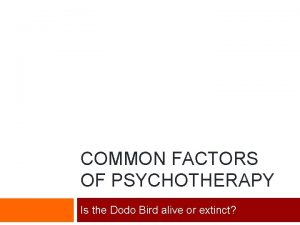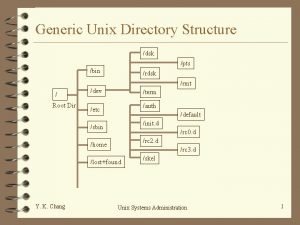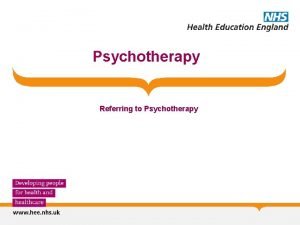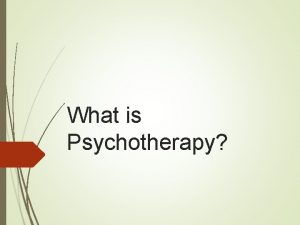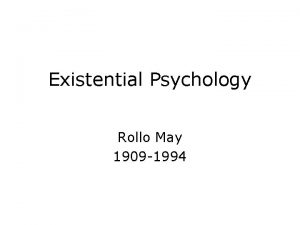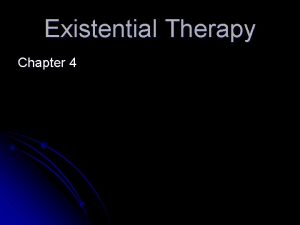Existential Psychotherapy in the PTS A qualitative and

















- Slides: 17

Existential Psychotherapy in the PTS A qualitative and quantitative exploration of goals and goal attainment

Introduction l l Existential psychotherapy The NHS climate l l Different types of evidence l l l Evidence-based psychotherapies Evidence-based practice and practice-based evidence Qualitative and quantitative research Goals in psychotherapy

Research questions l l What are the goals of clients receiving Existential Psychotherapy in the Psychological Therapies Service (now the Complex Care Team)? Is clients’ level of psychological distress any different after therapy? To what extent do clients feel that each of their goals has been met after being offered approximately 16 sessions of existential psychotherapy? Is the level of goal attainment linked with levels of psychological distress, or with number of sessions attended?

Method l l Participants l n = 30, 21 women, 8 men, 1 unrecorded gender. l Aged 19 -60 years (µ = 43) l 30% white European or white other, 70% no data Measures l CORE goal attainment form: l l l CORE-OM: l l At start of therapy: clients write down up to 4 goals/difficulties they want help with. At end of therapy: rate extent to which therapy helped with each difficulty/goal 34 items, 4 domains, overall score of psychological distress. Other measures not studied here – CORE-5

Results l Descriptive statistics: l l Average 4. 5 m in therapy, attended 12 sessions (ranging from 1 to 24 sessions). 20 participants attended a full course of therapy, for 8 therapy ended early and no data for 2.

CORE-OM l 75% of clients completed at start, 62. 5% at end of therapy. Clients had significantly lower scores at the end of therapy than at the start, showing a reduction in their distress. l Before (M = 22, SE = 1. 4), After (M = 16. 50, SE = 1. 5), t(19) = 3. 45, p =. 003; l CI (95%) = 2. 16 – 8. 84. l l Medium to large effect, d =. 77 or r =. 63. Reliable change (Jacobson & Truax, 1991) for 20 clients: l reliable change, less distress: 11 clients (55%). l reliable change, more distress: 1 client (5%). l no reliable change: 8 clients (40%).

l No link between post-therapy CORE-OM scores and Level of goal attainment l l But there is a link between post-therapy CORE-OM scores and goal attainment for Goal 1 l l l (for both mean and best level of goal attainment per client) (Spearman’s Rho = -. 586, p =. 028) Goal 1 is probably a client’s most important goal No link between post-therapy CORE-OM scores and number of sessions attended l (r =. 27, p =. 26).

Goals: Thematic analysis l l 25 participants wrote down a total of 77 goals (5 participants had no goal forms). 60% of participants wrote down 3 or more goals. Length: 1 to 74 words (µ = 11 words). 6 themes, some goals in more than one theme.

Themes and sub-themes l 1. Self l l l Acceptance Respect 2. Relationships l l l Family Attitude Roles Independence Relating

l 3. Acceptance l l 4. Making changes l l Building a future Embrace life Behaviour 5. Feelings l l l Past Present Future More positive feelings Fewer negative feelings 6. Miscellaneous

Goals: quantitative analysis l l Of all 30 clients: 83% wrote at least one difficulty at the start, 60% (20 clients) rated a total of 57 goals at the end of therapy (20 goals unrated), on this scale: How much did therapy help you with this difficulty? 0 Not at all l 1 A little bit 2 Moderately 3 Quite a bit 4 Extremely Of these 20 clients: l most (78%) wrote down three or more goals for therapy.

Goal attainment: All goals

Goal attainment per client: Goal 1

Highest level of goal attainment per client

Mean level of goal attainment per client

Discussion l Strengths: l Combined quantitative and qualitative data l High ecological validity l Important time to gather this data l Limitations: l No control group l Incomplete data l Small sample size l Some goals not very detailed l Difficulty separating themes - all interlinked l My inexperience with Existential Psychotherapy

l Recommendations: l l Good outcomes, pat on the back! Continue to help clients achieve their goals, through Existential Psychotherapy, particularly their main goal (Goal 1). Therapists to value data collection - integrate more in therapy, not just tick-box exercise. Thorough – goals at start, re-rate at end.


